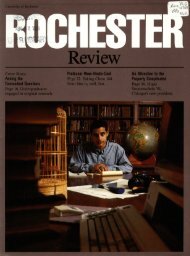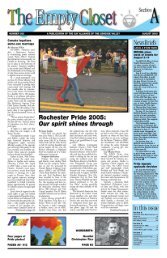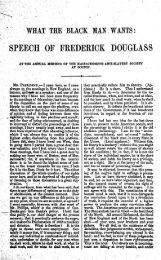Download PDF - University of Rochester Libraries
Download PDF - University of Rochester Libraries
Download PDF - University of Rochester Libraries
Create successful ePaper yourself
Turn your PDF publications into a flip-book with our unique Google optimized e-Paper software.
expanded by including Thomas<br />
Forbes, John Frazer, and John B.<br />
Goetsch, all <strong>of</strong> whom went on to<br />
distinguished careers in the field <strong>of</strong><br />
medical science, a surprising number<br />
came as scholarship holders from the<br />
Chicago area, recruited by Samuel<br />
Havens '99 (brother <strong>of</strong>James<br />
Havens, who with George Todd was<br />
instrumental in urging the River<br />
Campus site).<br />
Finally, the building <strong>of</strong> the River<br />
Campus brought both advantages<br />
and disadvantages to the women <strong>of</strong><br />
the <strong>University</strong>. No longer were they<br />
confined to "Katy" Strong Hall or<br />
the silent rear <strong>of</strong> recitation rooms.<br />
Women could now use the main<br />
stairs <strong>of</strong> Anderson Hall. All the<br />
buildings <strong>of</strong> the Old Campus (the<br />
designation <strong>of</strong>ficially adopted by the<br />
trustees, which fortunately gave way<br />
to "Prince Street Campus") were<br />
renovated for their special uses. A<br />
new dormitory was constructed. So<br />
was the beautiful Cutler Union, from<br />
funds bequeathed by trustee James<br />
G. Cutler, whose interest in<br />
women's education was<br />
long-standing.<br />
(Legend has it Cutler was overruled by<br />
the rest <strong>of</strong> the building committee in<br />
his espousal <strong>of</strong> Collegiate Gothic<br />
architecture for the River Campus<br />
and achieved his posthumous revenge<br />
when Gordon and Kaelber were<br />
allowed to give free flight to their<br />
Gothic fancies in this $750,000<br />
structure.)<br />
Following the removal <strong>of</strong> the men,<br />
the women were free to develop their<br />
own traditions, leadership, and esprit<br />
de corps. The consensus <strong>of</strong> those who<br />
recall this twenty-five-year period on<br />
the women's campus affirms that<br />
these qualities saw their greatest<br />
flowering then. Also, the percentage<br />
<strong>of</strong> woman members <strong>of</strong> the joint faculty<br />
was higher in this segregated<br />
period than before or since on a<br />
single campus.<br />
On the negative side, almost the<br />
entire library was removed to the<br />
River Campus, accessible but to a<br />
lesser degree (129,003 volumes went;<br />
22,213 stayed). Women who wanted<br />
a scientific concentration had to find<br />
ways to reach the River Campus as<br />
efforts to establish laboratory facilities<br />
at Prince Street went unrewarded.<br />
Scheduling difficulties became legion<br />
and the four-mile trip back and forth<br />
between campuses several times a day<br />
sorely tried tempers. Eventually, the<br />
maintenance <strong>of</strong> so many duplicate<br />
facilities became an unbearable financial<br />
burden, and in 1955 the experiment<br />
in "coordinate education" came<br />
to an end as women students joined<br />
the men on the "new campus."<br />
All this was in the future in the<br />
early fall <strong>of</strong> fifty years ago when the<br />
student newspaper, recalling the days<br />
when the Old Campus was the site <strong>of</strong><br />
Deacon Boody's cow pasture, bade<br />
"Farewell to Boody":<br />
"There is no use being sentimental<br />
about it. . . . But though we . . . try<br />
to preserve our nonchalant equanimity,<br />
we cannot honestly feel the stolid<br />
bovine indifference <strong>of</strong> Deacon<br />
Boody's kine. There are too many <strong>of</strong><br />
us that have grown to love the old<br />
campus.<br />
"And we must now grow to love<br />
the new one. We must readjust<br />
ourselves to the strange environment<br />
and lack <strong>of</strong> shade. We must breathe<br />
into the fresh buildings life, traditions<br />
-all that will make our river campus<br />
a living force, a true 'alma mater.' A<br />
task for time, perhaps."<br />
Author's note: Special thanks for first-hand<br />
remembrances, long-range perspectives, wellturned<br />
phrases, and assistance in ferreting out<br />
materials to Charles Dalton, George Darling,<br />
Kathrine Koller Diez, R uhard Greene, Karl<br />
Kabelac, Carl F. W Kaelber, Jr., Keith<br />
Marvin, Charles Urlaub, and Philip Will, Jr.<br />
Arthur May's unedited manuscnpt <strong>of</strong> the history<br />
<strong>of</strong> the <strong>University</strong> was most helpful, too.<br />
Betsy Brayer, a frequent contributor to the<br />
Review, is preparing a book about George<br />
Eastman.<br />
One <strong>of</strong> the first events on the new campus<br />
was the freshman- sophomore flag rush,<br />
witnessed by a hillfull <strong>of</strong> interested<br />
observers. The rules proscribed<br />
"all missles [sic] other than those provided by<br />
nature," a handicap that did not prevent<br />
the freshmen from winning. Had they<br />
also won the frosh- soph push ball contest<br />
they would have been allowed to "wear<br />
knickers the rest <strong>of</strong> the year, a privilege otherwise<br />
denied them."<br />
15
















